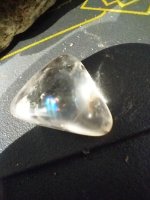WV Hillbilly
Hero Member
I have seen several illustrations of a single frequency detectors signal . General concensus
seems to be that the signal goes down in a v shape . After the signal gets a few inches deep it
narrows to a pinpoint like a v . Once it reaches this pinpoint does it go deeper or is the point the
max depth of the signal strenght ?
If the point of the V , U , or OVAL shape is the max depth of the signal how can a detector
hit on a large iron target , say two or three feet deep . That would mean that the point of V , U ,
or oval shape made by the detectors signal is much deeper than just several inches . That would
also put coin sized objects six or seven inches deep way up toward the top of the detectors signal
field . I have read many statements that said go slow & overlap your sweeps because the detectors
signal is narrowing down to a point as it gets several ( inches ) deep . Also most people seem to
agree that coins over about eight inches is getting fairly deep . Jump right in folks , I'm curious .
seems to be that the signal goes down in a v shape . After the signal gets a few inches deep it
narrows to a pinpoint like a v . Once it reaches this pinpoint does it go deeper or is the point the
max depth of the signal strenght ?
If the point of the V , U , or OVAL shape is the max depth of the signal how can a detector
hit on a large iron target , say two or three feet deep . That would mean that the point of V , U ,
or oval shape made by the detectors signal is much deeper than just several inches . That would
also put coin sized objects six or seven inches deep way up toward the top of the detectors signal
field . I have read many statements that said go slow & overlap your sweeps because the detectors
signal is narrowing down to a point as it gets several ( inches ) deep . Also most people seem to
agree that coins over about eight inches is getting fairly deep . Jump right in folks , I'm curious .



